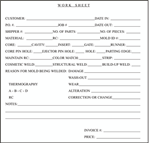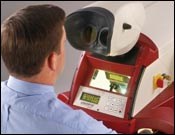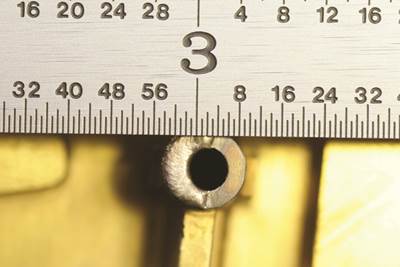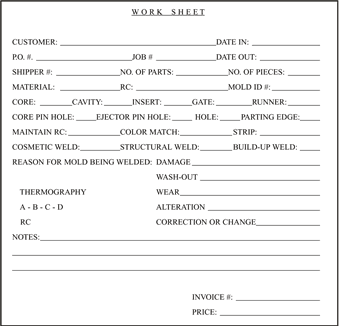The Tool of Choice for Mold Repair
Manual laser micro-welding systems are an alternative to traditional microscope GTA welding.
Today’s small precision welding shops specializing in plastic injection mold, die and tooling repair have a wide range of new technologies available to enhance their ability to provide the highest level of quality, craftsmanship and service to their clients. One of the fastest growing technologies is the use of manual laser micro-welding systems as an alternative to traditional microscope GTA welding.
Laser is an acronym for Light Amplification by the Stimulated Emission of Radiation. This technology produces a sharply focused beam of hot light that melts a very small area of metal and can be used to join similar or dissimilar alloys.
The welding process can be performed quickly (normally in milliseconds) and does not scar or blemish the welding surface. In fact, by adjusting the laser’s beam diameter, a smooth, near polished finish can be achieved with the laser.
Since very little heat is generated at the weld point, users can easily weld 0.10mm away from the most complicated and intricate machined patterns, polished surfaces and removable component assemblies.
Lasers can be used to fill porosity, re-fill damaged surfaces including porosity and pits, run a bead of alloy along a complex edge and correct manufacturing defects. Laser welding reconfigures the molecular structure of either similar or dissimilar metals at the point of welding—allowing the two common alloys to become one.
Tool and die shops currently using laser welders are often amazed at the wide range of applications and ability to produce a higher quality product in less time with fewer materials while eliminating excessive heat effects.
How the Laser System Works
One of the key elements in making laser welding applicable to tool and die repair was the development of the “free-moving” concept. In this approach, the laser generates a stationary infrared light pulse, which is targeted through the microscope’s cross-hair. The laser pulse can be controlled in size and intensity.
Because the heat generated remains localized, operators can handle or fixture items with their fingers, welding small areas with pin-point accuracy without causing any harm to the operator’s fingers or hands. This free-moving concept enables users to eliminate costly fixturing devices and increase the range of assembly and repair applications.
In laser welding systems, the operator controls the beam diameter (weld spot), power level (voltage), and pulse length depending on the type of alloy and joint being welded. A stereomicroscope with internal cross-hairs makes it easy for the operator to align and weld the component part or assembly at the precise location. The laser pulse is then activated with a foot pedal. Many systems also offer the option of a cover gas—normally Argon—to ensure a homogeneous weld while preventing any discoloration or contamination.
Most operators can learn to use laser welding machines in a few hours, although to become fully proficient and benefit from the machine’s full potential, users must have a good understanding of the metallurgical properties of the alloys being welded. An experienced laser welding technician can typically perform basic manipulation of the repair item within minutes.
Laser spot-welders pose little hazard to operator’s fingers or hands while in the welding chamber. Occasionally, an operator’s fingers may experience a deflected laser pulse, but little damage is done. It is similar to a pin-prick or touching something hot.
To ensure the safety of your laser welding system, always ask the manufacturer before you purchase if the machine is FDA-certified according to the safety standards established by the Laser Institute of America.
Since most manual laser welders range in pulse energy from 40 to 150 joules of energy, or 30 to 150 Watts, they are normally categorized as a Class 4 laser device—the highest powered Nd:YAG laser available. When the welding chamber is fully enclosed, the system meets the Class 1 safety standards, which is the safest laser to operate.
Into the Future
During the last few years, the price of many laser welding systems has decreased, making them increasingly affordable to plastic injection mold manufacturers, small tool and die workshops, precision welding repair shops, and prototyping laboratories while offering additional features and flexibility for the user. Frequently, those who have purchased the laser systems find that the time, labor and material savings realized far outweigh the original purchase price.
Related Content
Machine Hammer Peening Automates Mold Polishing
A polishing automation solution eliminates hand work, accelerates milling operations and controls surface geometries.
Read MoreThe Ins and Outs of Hot Runner Temperature Control
A training checklist that explains the why and how of proper hot runner temperature control and system management.
Read MoreFour Micro Tooling Considerations
Issues involving gating, ejection, mold splits and direction of pull are of special concern when it comes to micro tooling.
Read MoreLaser Welding Versus Micro Welding
The latest battle in finely detailed restoration/repair of mold materials.
Read MoreRead Next
Laser Welding Versus Micro Welding
The latest battle in finely detailed restoration/repair of mold materials.
Read MoreThe Value of a Shop’s Welding Policy
To put the appropriate welding policy in place, you need to choose the right welder—someone who is familiar with tool steel and has a working knowledge of molds.
Read MoreHow to Choose the Best Welding Method for Your Mold Application
Moldmakers can save time and money on repairs by understanding the similarities and differences of conventional and micro TIG..
Read More






















